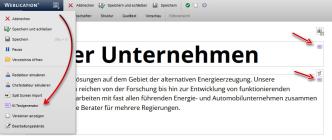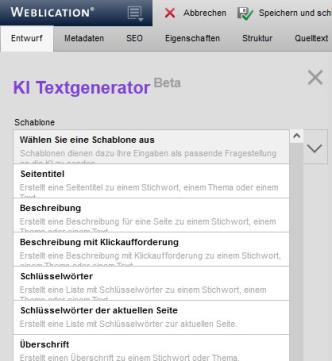AI interface
You can use the AI interface add-on module to connect an artificial intelligence (AI) to automatically generate and optimize texts and transfer them to the relevant fields at the click of a mouse. The basis for the interface is the API interface of various AI providers / platforms such as:
- OpenAI ( OpenAI / ChatGPT API)
- Gemini(Gemini API from Google)
- Anthropic(Anthropic API)
- Ollama(Ollama API)
- ...
(further AI interfaces on request)
An AI button is available in numerous places via the AI module to call up the screen for AI-based text generation. The button is displayed, for example, in:
- Metadata:
Title, description, keywords - Content in the content area:
Headings, texts, image element
The editor in Weblication® gives an AI a task for optimizing or generating texts, and the AI provides you with an automatically generated text based on its experience and underlying basic data, which you can adapt accordingly and transfer to the text fields in Weblication® with a click of the mouse.
Templates can be used to select typical supplied questions that speed up the process of posing questions to the AI for the editor, such as
- Optimize text for SEO
- Generates a keyword list for an FAQ
- Creates a text for a keyword or topic
- Creates a text for an image that describes the image (e.g. for the image caption)
Operation
First activate the module via the Weblication® CMS license. The license defines the number of users who can use the interface. Which users are allowed to use the AI interface is defined via the user administration for the corresponding user (see below).
The current BASE project basis is already equipped for the use of the AI functions with regard to the templates.
To use the AI interface, an API key from an AI provider is required, which must be entered in the system settings (AI). As a rule, a payment method for the tokens used must be stored for the account with the AI provider. With the OpenAI API, for example, the prices for the tokens used vary depending on the model used (gpt-4o, gpt-3.5, etc.).
'IMPORTANT':
OpenAI:
Copy the OpenAI key directly after generation from the OpenAI platform, as it will not be displayed again in full length afterwards!

Auszug aus der Projektkonfiguration (default.wVariables.php)
... <headline versionMin="18" text="KI Unterstützung"/> <variable versionMin="18" description="OpenAI Schlüssel" key="openai_api_key" type="char.default"/> ...
Enable users for AI use
The AI interface in Weblication® CMS is activated via the license and also defines the number of users who can use the AI functions (text generator, etc.).
In the user administration, call up the user for editing who is to use the AI functions. In the"General" tab, activate the "May use the AI interface" parameter for the user.
Use AI interface
The functions of the AI interface are now available to you in page editing.
An AI symbol is visible for each heading and text field, which opens the AI text generator screen and enters the text for the corresponding field in the query field. A click on the "Send to AI" button transmits this to the connected AI and delivers the answer after a short time.
In addition, the "AI text generator" can be opened independently of a text field via the Weblication® layer at the top left of the menu. Weblication® provides templates for typical questions, which you select and send to the AI together with the textual specification of your request. The AI uses these templates to provide you with a suitable text.
The templates provided speed up the input of typical questions for editors. The templates supplied include, for example
- Optimize text for SEO
- Generates a keyword list for an FAQ
- Creates a text for a keyword or topic
- Translates text -> language selection
- and much more ...



It is also possible to use the AI via the image element for the title of the image. Azure access can also be entered in the project configuration for this purpose, but this is no longer recommended. OpenAI now offers this function in current versions, which means that additional Azure access is no longer required.
By clicking on the AI symbol in the title field, the image is sent to the connected AI and a description of the image is returned, which can be added to the title by clicking on it.
'General information':
The AI function for the project can also be deactivated via the project configuration (ai_active). This may be the case if, for example, plain language is to be used but without AI functions.


